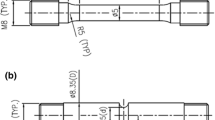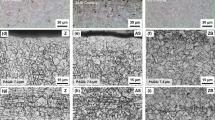Abstract
Based on the experimental results of Part I of present work, this paper describes results of FEM calculations and analyses in details which identified that the effect of tensile-warm pre-stressing (WPS) on improvement of the apparent toughness of notched specimens results from three factors i.e. the residual compressive stress, macroscopic blunting of the original notch, and prestrain-deactivating cleavage initiation. The effects of three factors are separated and is effective for each at various extents of prestressing specified with a prestress-ratio, P0/Pgy, defining the prestressing load P0 as a fraction of general yield load Pgy. For values of prestress-ratio lower than 1.0, the residual compressive stress acts as the main factor. Between 1.0 to 1.5 of prestress-ratio values, in addition to the residual compressive stress the macroscopic blunting plays increasing role. The effect of the prestrain-deactivating cleavage initiation presents at the prestress-ratio P0/Pgy≥1.2. In the case of compressive-warm prestressing, the apparent toughness is deteriorated due to the residual tensile stress. The effects of complex cycles of WPS, with various steps of loading and unloading different in signs, are determined mainly by the loading step just before the fracturing step.
Similar content being viewed by others
References
Chell, G.G., Haigh, J.R. and Vitek, V. (1981) A theory of warm prestressing: experimental validation and the implications for elastic plastic failure criteria. International Journal of Fracture 17, 61–81.
Chen, J.H., Zhu, L. and Ma, H. (1990) On the scattering of the local fracture stress ? f. Acta Metall. Mater. 38, 2527–2535.
Chen, J.H., Wang, V.B., Wang, G.Z. and Chen, X. (2001), Mechanism of Effects ofWarm Prestressing on Apparent Toughness of Precracked Specimens of HSLA Steels. Engng. Fract. Mech. 68, 1669–1686.
Chen, J.H., Pippan, R., Hebesberger, T. and Kolednik, O. (2002) The fracture behavior of intermetallic TiAl alloys with and without warm prestressing, Inter. J. Fract. 113, 327–343.
Cox, T.B. and Low JR., J.R. (1974) An investigation of the plastic fracture of AISI 4340 and 18 nickel–200 grade maraging steel. Metall. Trans. 15, 1457–1470.
Curry, D.A. (1983) A model for predicting the influence of warm pre-stressing and strain ageing on the cleavage fracture toughness of ferritic steels. International Journal of Fracture 22, 145–159.
Harrison, T.C. and Fearnehough, G.D. (1972) The influence of warm prestressing on the brittle fracture structure containing sharp defects. J. of Basic Engineering june, 373–376.
Nichols, R.W., Kienzler, R. and Nagel, G. (1968) The use of overstressing techniques to reduce the risk of subsenquent brittle fracture. Part I: British Welding J. 15, 21–42 and 75–84.
Reed, P.A.S. and Knott, J.F. (1989) Warm prestressing effects in notched bars of aMnNiMo steel weld-metal. Adv. Res. Fract. Proc. Of ICF7 Vol. 4. Pergamon, New York, pp. 2583–2593.
Reed, P.A.S. and Knot, J.F. (1996a) Investigation of the role of residual stressing in the warm prestress (WPS) effect, Part I-experimental. Fatigue Fract. Engng Mater. Struct. 19, 485–500.
Reed, P.A.S. and Knot, J.F. (1996b) Investigation of the role of residual stressing in the warm prestress (WPS) effect, Part II-analysis. Fatigue Fract. Engng Mater. Struct. 19, 501–513.
Ritchie, R.O., Knott, J.F. and Rice, J.R. (1973) On the relationship between critical tensile stress and fracture toughness in mild steel. J. Mech. Phys. Solids 21, 395–410.
Shum, D.K.M. (1995) Interpretation of warm prestress-induced fracture toughness based on crack-tip constraint. Fracture Mechanics: 25th volume, ASTM STP 1220 Ed. F. Erdogan, 686–704.
Stoeckl, H., Boeschen, R., Schmitt, W., Varfolomeyev, I. and Chen, J.H. (2000) Quantification of the warm prestressing effect in a shape welded 10 MnMoNi5-5 material. Engng. Fract. Mech. 67, 119–137
Author information
Authors and Affiliations
Rights and permissions
About this article
Cite this article
Chen, J., Wang, H., Wang, G. et al. Mechanism of effects of warm prestressing (WPS) on apparent toughness of notched steel specimens Part II: Calculations and analyses. International Journal of Fracture 117, 375–392 (2002). https://doi.org/10.1023/A:1022251128300
Issue Date:
DOI: https://doi.org/10.1023/A:1022251128300




